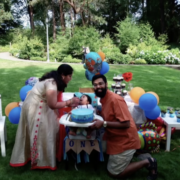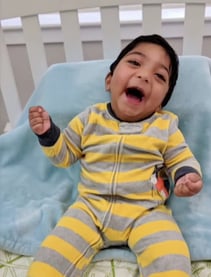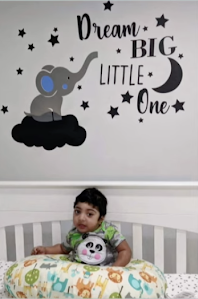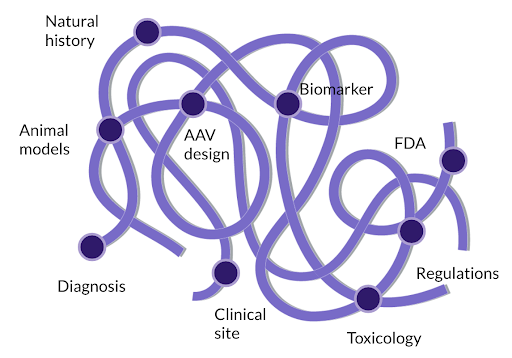A Rarity in Open Source
Dan Whiting | 14 April 2022
About 3 ½ years ago, Sanath Kumar Ramesh and his wife welcomed their son, Raghav, into the world. Like any new parents, he immediately became their everything. And, as new parents do, they threw him a 1st birthday bash where many of their friends and family were meeting Raghav for the first time.
As Sanath was getting ready to cut the cake, he received a call from  Raghav’s doctor. The doctor informed him they received the results from a battery of tests and, “We think he has an ultra-rare genetic disease called SSMD (Spondylometaphyseal Dysplasia), but, unfortunately, we don’t know much about the disease because all of the other kids died just a few weeks after birth. Your son is lucky to be alive.”
Raghav’s doctor. The doctor informed him they received the results from a battery of tests and, “We think he has an ultra-rare genetic disease called SSMD (Spondylometaphyseal Dysplasia), but, unfortunately, we don’t know much about the disease because all of the other kids died just a few weeks after birth. Your son is lucky to be alive.”
Sanath recounts, “I was taken aback. I was standing at my son’s first of many birthday parties to come and someone was telling me that Raghav was lucky to be alive. This was a turning point in my career – in my whole life.”
 In plain English, he has a typo in his GPX4 gene. The G became A. Consequently, he can’t sit, stand, walk, or eat by mouth.
In plain English, he has a typo in his GPX4 gene. The G became A. Consequently, he can’t sit, stand, walk, or eat by mouth.
Raghav has what is called an ultra-rare disease. Only 9 other children have been diagnosed around the world.
Sanath called hundreds of hospitals, doctors, researchers, etc. and found no treatments. So, he took matters into his own hands. He tried 5 different drugs for his son and saw some improvements, but not enough to “give him the life he deserves.” Raghav did lift his head up at 13 months – something he never did before. At 3, he is still unable to sit, stand, walk, and talk, and it looks like his disease is progressing faster than they anticipated.
While SSMD only has a handful of known patients, 400 million people around the world live with over 7,000 rare diseases and disorders. 93% have no FDA-approved treatment.
So, Sanath began asking researchers, How do we bring treatments to all of the rare diseases? Unfortunately, there is no simple solution. The drug development process is a maze and the biology of most is a complete mystery. But the advice he got was to foster open collaboration, lower the cost, and operate at a global scale.
 Well, that sounds exactly like the open source model – something Sanath knows well. So, in March 2021, he started the Open Treatments Foundation with the mission to, “Create a society where there is at least one treatment for all genetic diseases accessible to all patients.” That is one giant BHAG.
Well, that sounds exactly like the open source model – something Sanath knows well. So, in March 2021, he started the Open Treatments Foundation with the mission to, “Create a society where there is at least one treatment for all genetic diseases accessible to all patients.” That is one giant BHAG.
They settled on four strategies:
- Put every disease on the map: increase disease awareness, build a robust patient community
- Make diseases easy to work with: open source animal models, assays, and natural history data
- Generate more money for research: crowdfunding, incentive-based funding, etc.
- Create more drug developers: decentralize drug development, go global
They also chose to collaborate with The Linux Foundation on the open source software and created the RareCamp project to house the source code under an Apache 2.0 license and to create and foster a community. The ball is rolling.
On a more personal level, I spent the previous five years working for individuals with rare disorders and diseases. Specifically, I worked at the National Fragile X Foundation. Fragile X syndrome is an inherited, intellectual/developmental disability and is rare (but not ultra-rare). My advocacy extended to all individuals with rare diseases/disorders through groups like the EveryLife Foundation and the Friends of the National Center for Birth Defects and Developmental Disorders – so I am especially excited to see this work.
Our Fragile X parents would often say this isn’t the life they anticipated or hoped for, but they are better for it. I would say our world will be a better place because of sweet Raghav and all the work he is inspiring. Are you inspired? Join us! As Jim Zemlin said when Sanath spoke at the 2021 Open Source Summit, this project is about, “personal motivation and a collective response.” Can you be part of the collective response? Visit rarecamp.org.
This is just one of the many projects at The Linux Foundation that has the potential to make a major, positive impact on the world. As Jim also stated, “We are just getting started addressing huge issues like rare diseases.”
